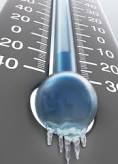
Frostbite
Frostbite results from the body's survival mechanisms kicking in during extremely cold weather. The body's first imperative is to protect the vital inner organs, which it does by cutting back on circulation to your extremities: feet, hands, nose, etc. If these parts are exposed to the cold and receive less warming blood flow, they eventually freeze.
Different Degrees of Frostbite
- First degree – ice crystals forming on skin.
- Second degree – your skin begins to feel warm, even though it is not yet defrosted.
- Third degree – your skin turns red, pale, or white.
- Fourth degree – pain lasts for more than a few hours, and you may see dark blue or black areas under the skin. See the doctor immediately if these symptoms arise.
Frostbite First Aid
- Do not rub frostbitten skin with snow. That old-time remedy can cause permanent damage.
- Never rub or massage. Use your armpits, a warm companion, warm drinks, and warm clothes to thaw your frozen body parts.
- If you notice signs of frostbite, immediately seek medical attention.
- Remove rings, watches, and anything that is tight.
- Place sterile gauze between toes and fingers to absorb moisture and to keep them from sticking together.
- Slightly elevate the affected part to reduce pain and swelling.
- Get in doors, as soon as possible, avoid walking on a frostbitten foot if possible.
- If you have access to warm water (not hot), place frostbitten part in the water (100 to 105 degrees F). Rewarming usually takes 20 to 45 minutes or until tissue softens.
- Don't get near a hot stove or heater and don't use a heating pad, hot water bottle, or a hair dryer. You may burn yourself before feeling returns.
- Frostbitten skin will become red and swollen, and you'll feel like its on fire. You may develop blisters, don't break the blisters. It could cause scarring.
Avoiding Frostbite
- Avoid going outdoors during severe cold, especially if the wind chill is -50 degrees F or below.
- If you must go outside, be sure to protect the exposed parts of your body, such as ears, nose, toes and fingers.
- Mittens are more effective than gloves for warming your hands.
- Keep your skin dry.
- Stay out of wind, when possible.
- Drink plenty of fluids. Hydration increases the blood's volume, which helps prevent frostbite.
- Avoid caffeinated beverages, as they constrict blood vessels and prevent warming of your extremities.
- Avoid alcohol since it reduces shivering, which is one of your body's ways of keeping warm.
- Avoid smoking. According to some physicians when you smoke, the blood flow to your hands practically shuts off.
Hypothermia

Hypothermia occurs when the body's temperature drops below 95 degrees F and it does not take arctic temperatures to put you at risk. Even moderately chilly air temperatures can trigger hypothermia if you are not probably clothed.
The National Institute of Aging estimates that of the 28,000 people hypothermia kills every year, the largest percentage are older people. Some medicines, problems with circulation, and certain illnesses appear to reduce the older persons ability to resist hypothermia. The older you get, the less sensitive your are to cold weather. So, your body temperature could drop to a dangerously low level without you being aware of it.
Preventing Hypothermia
- Dress in layers.
- Always wrap us well when going outside in the cold.
- Set your thermostat to at least a toasty 70 degrees during cold weather.
- Avoid extensive exposure to breezes and drafts.
- Keep plenty of nutritious food and warm clothes and blankets on hand to ward off the winter chill.
- Wear a warm hat during during the winter months.
- Eat hot foods and drink warm drinks several times during the day.
- Ask a family member or neighbor to check on you often.
- Ask your doctor if any medicine you are taking increases your risk of hypothermia. Some drugs make it difficult for your body to stay warm.
- Avoid becoming wet, as wet clothing loses 90 percent of its insulating value.
Hypothermia Symptoms
- Feeling sluggish.
- Change in mental status, trouble thinking clearly.
- Uncontrollable shivering.
- Cool abdomen and low core body temperature.
- Severe hypothermia may produce rigid muscles, dark and puffy skin, irregular heart and respiratory rates, and unconsciousness.
If you feel any of these symptoms , see your doctor immediately or go to the nearest emergency room. It is better to be overly cautious.
Treating Hypothermia
To help someone you suspect may be suffering from hypothermia:
- First, call an ambulance.
- Get the victim out of the cold, if possible.
- Lie close to the person and cover both of you with warm blankets. The hotter you get, the more warmth you can give the other person.
- Don’t rub the person or handle them roughly, rough handling can cause cardiac arrest.
- Replace wet clothes with dry clothing.
- Keep the victim in a horizontal position.
- Give artificial respiration or CPR (if you are trained), if necessary.
Sources: National Oceanic and Atmospheric Administration (NOAA), National Institute of Aging (NIA), and National Safety Council (NSC)
